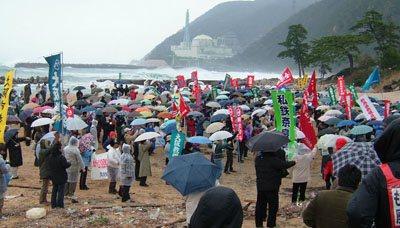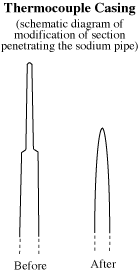Can safety be assured in the Monju modifications? Nuke Info Tokyo No. 110
On 7 February 2005, Fukui Governor Issei Nishikawa granted approval for the start of modifications to the Monju fast breeder reactor (FBR, 280 MW), which had been shut down for over nine years. Upon receiving this approval, the former Japan Nuclear Fuel Cycle Development Institute (JNC) (now JAEA) started work on the modifications. On May 30th, as if all these players were working in collusion, the Supreme Court reversed the Nagoya High Court decision, which had acknowledged the claims of the plaintiff citizens and ruled that the license approval of the facility was invalid1 (see NIT 107).
 |
| Protest scene – Monju in the background (Photo by Kiyohiko Yamada) |
The Fukui Governor’s approval is reputed to be part of a deal to to extend the bullet train line to Fukui Prefecture and to obtain a 1.9 billion yen budget for a planned center for energy research and development in Fukui Prefecture.
It is stated in the AEC’s “Framework for Nuclear Energy Policy”, that the aims of restarting operations at Monju are “demonstrating reliability as an operational power plant and establishing sodium handling technology”2. The aim is to achieve these goals within approximately 10 years and then make Monju a center for international cooperation. It seems as though any intention to position Monju as a breeder reactor has in fact been abandoned.
It is doubtful that Monju’s reliability as a power-generating reactor can be proven, but even if it could be this would be of no use, as there is no future for Monju3. Furthermore, only one third of the operators who were working at Monju before the accident are still there. Even if the number of staff was increased and the new operators gained experienced, there are no future prospects for them.
Regarding sodium handling technology, prior to Monju first achieving criticality, Power Reactor and Nuclear Fuel Development Corporation (PNC – previous incarnation of JNC) claimed to have already established this technology. The sodium accident in 1995 proved that this was not true. It is ironic that they now claim the need to establish sodium handling technology as a reason for restarting Monju.
As of 2004, 1.7 trillion yen had been spent on the development of FBR cycle technology. Of this, 810 billion yen was direct investment in Monju. Even while it was inoperable due to the accident, about 10 billion yen was squandered every year on maintenance and management4. 18 billion yen is to be spent on the modifications, and 15 billion yen will be spent each year to maintain operation. All this, despite the absolute meaninglessness of these investments.
 The first step in the modifications will be the replacement of the thermocouple casing that was the cause of the sodium leak accident ten years ago. The said thermocouple casing ruptured from vibration during the flow of sodium. The section that penetrated the pipe in which the sodium flowed had an angular structure. This section of the new thermocouple has a shorter, smoother shape. The replacement of the thermocouple was to begin on 12 December 2005.
The first step in the modifications will be the replacement of the thermocouple casing that was the cause of the sodium leak accident ten years ago. The said thermocouple casing ruptured from vibration during the flow of sodium. The section that penetrated the pipe in which the sodium flowed had an angular structure. This section of the new thermocouple has a shorter, smoother shape. The replacement of the thermocouple was to begin on 12 December 2005.
Secondly, measures will be taken to respond to sodium leaks. Specifically, cell monitors will be installed for early leak detection. The drainage system will be modified, including adding drain pipes to shorten the time it would take to extract sodium in the event of an accident. In addition, measures to mitigate the effect of a leakage will include the installation of insulation on walls and ceilings, a nitrogen gas infusion apparatus, and the installation of a comprehensive video monitoring system. While it seems that solid countermeasures are being taken, doubt remains about the efficacy of these measures. For example, while the drain pipes will be changed to large caliber, the opening into the final drain tank will remain at its original size. On the other hand, if this opening were to be changed to large caliber, there would be an increased risk of a rupture in the overflow tank itself due to thermal shock.
In sodium leak testing following the accident, five holes, both large and small, opened in the steel floor liner. PNC did not have knowledge of the chemical reaction (molten salt reaction) at high temperatures between sodium and steel. Nevertheless, additional measures give no consideration to increasing the thickness of the floor liner.
The third step will be measures regarding the steam generator. Specifically, in order to deal with a water-sodium reaction accident caused by a water leak from the steam generator heat transfer tubes, a steam generator cover gas pressure gauge will be installed. Further, additional modifications will be carried out for a release valve to improve the drainage performance of water and steam from inside the heat transfer tubes (blow down). With only one system to communicate pressure, merely adding a cover gas pressure gauge to the steam generator (leaving the heater as is) will be of no use if a breakdown occurs here.
These measures are being taken to counter the high-temperature rupture of heat transfer tubes. This is an issue which JNC kept hidden, as was revealed by the plaintiffs during the court battle. The safety evaluation claims that high-temperature ruptures can be prevented by the additional countermeasures. However, the safety evaluation was based on flimsy evidence, since only twice in the past have experiments been conducted on high-temperature ruptures.
The measures described above are mainly related to sodium, but it cannot be said that these make Monju safer. There are dangers that are inherent to Monju which remain unchanged. These include the danger of a run-away chain reaction and safety problems with the piping. The piping above the reactor is designed to cope with expansion at high temperatures (not fixed and winding around rather than straight), but this is a weakness in the case of earthquakes. Further, the elapse of ten years has no doubt caused degradation of the sodium and deterioration of machinery and pipes. One wonders to what extent the issue raised by the Monju Safety Assurance Investigative Committee5 regarding the “confirmation of the soundness of machines, systems and fuel not used for a long time” will be addressed. It is impossible to check all the machinery, so it is unlikely that the safety assurance demanded by the community will be provided.
Further, a previously unknown active fault was discovered by the Headquarters for Earthquake Research Promotion. The Urasoko fault connects with the Yanagaseyama fault on the ocean floor of Tsuruga Bay, with the latter extending to Shiga Prefecture. JNC asserted that while it had not taken this earthquake into account, according to results of calculations it would not be a problem. There is nothing to point to the objectivity of these calculations. Research is being extended to Wakasa Bay, and it is feared that research results could show that an earthquake associated with this fault would exceed the safety specifications. So it cannot be said that the modifications will improve Monju’s safety.
A large meeting calling for the shut down of Monju was held on December 10th. It was led by the anti-nuclear power group, Fukui Residents’ Committee. CNIC was a sponsoring group. At the meeting, it was confirmed that a monitoring committee of citizens would be established to check on the modifications, while continuing to engage in activities toward the shut down of the reactor.
Hideyuki Ban (CNIC Co-Director)
1. The plaintiffs lodged an appeal for a review of this decision, but their appeal was rejected on 15 December 2005. Judges of the Supreme Court are divided into three groups. Some people have questioned the probity of the fact that the same group of judges which made the original decision also heard the appeal. There are now no further avenues for appeal.
2. Framework for Nuclear Energy Policy, Japan Atomic Energy Commission, October 11, 2005, p. 39
3. On December 26th the Nuclear Power Subcommittee of the Advisory Committee for Natural Resources and Energy began a debate regarding the realization of the nuclear fuel cycle. During the proceedings the Agency of Natural Resources and Energy, which provides the secretariat for the above subcommittee, announced the following: (1) a successor to the Monju prototype FBR would be installed by around 2030; (2) a second reprocessing facility would begin operations around 2045. Neither of these plans is realistic and, significantly, there was no indication that the Monju successor would be upgraded to ‘demonstration reactor’ status. This suggests that they don’t expect to achieve much with Monju. Furthermore, it is unclear who would install a successor to Monju. Would it be an agency of the government, or would it be the power companies? No one seems eager to take on this responsibility.
4. Monju has continued to consume a large quantity of electricity ever since the accident. Most of the electricity consumed is used to heat the sodium liquid, which remains in the reactor. Details of electricity consumption for 2004 are as follows:
Hokuriku Electric Power Company was contracted to provide 70,127,000 kWh in 2004 at a price of 695,572,563 yen. In fact, the final consumption for that year was only 58,533,960 kWh, but being a fixed price contract, the price did not change.
5. This committee began in November and is part of the Nuclear Industrial and Safety Agency’s Nuclear Reactor Safety Subcommittee.


